Only 150 kilometres from Australia, this country is another world
Only four kilometres separates Papua New Guinea from an Australian island. Or 150 kilometres if you measure from Cape York to the PNG mainland. Yet it’s a world away, for all Australians know about it.
Tourists hardly visit. But they should. Poor infrastructure makes access difficult and security can be a concern, yet on an expedition cruise you can explore this most fascinating destination with ease.
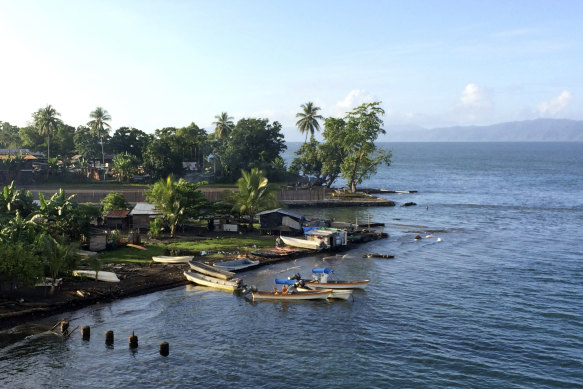
Alotau, Papua New Guinea. The country is just 150 kilometres from the Australian mainland, but feels like another world. Credit: iStock
You’ll be at sea for a day and a half when you sail out of Cairns; PNG’s closeness doesn’t mean convenience. Still, that’s no hardship when you’re on Ponant’s sleek ship Le Soleal. This boutique hotel afloat is smart but informal. I attend a lecture on New Guinean politics. Head to the open bridge and chat to captain Antoine Paquet. I gobble seared scallops and chicken Paillard and fall asleep.
At 7.30 the next morning we’re heading through China Strait between islands and mainland PNG’s south-east tip towards Alotau, which has no land connection to the outside world. We sail past shipyards, oil-storage tanks, rusting boats and shiny trucks. The cruise terminal is a tin warehouse with faded blue doors.
An assortment of crumpled buses has been commandeered for our afternoon excursion. When my driver Andrew sees me studying his bare feet, he assures me there are no scorpions in PNG. But there are poisonous snakes: they live in the palm-oil plantations and can stop your heart in five minutes.
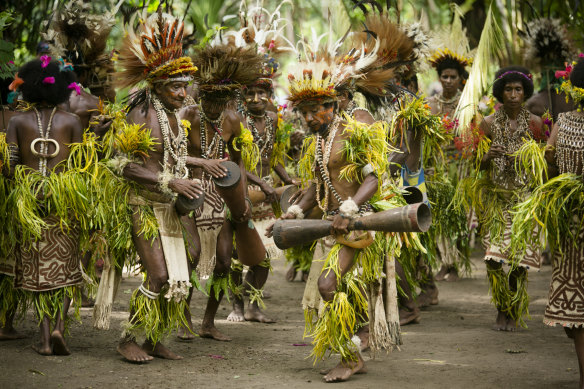
A Tufi welcome ceremony.
The local museum is afloat in gardens of mud. Its two rooms offer desultory information about carvings, canoes, missionary settlements and the Battle of Milne Bay, better brought to life by shy staff who, when asked, prove eloquent. Initiating conversation is the key to PNG. Locals are friendly, well-educated and more than they might seem: businesspeople, student teachers, engineers.
Early next morning, we’re nosing into the green, voluptuous Tufi coastline. No roads here either. We transfer onto outrigger canoes, mine paddled by a young man called Simon, feathers in his hair, shell necklaces clanking on his bare chest.
Mangrove roots claw at the riverbanks as we paddle under a canopy of trees. Women adorned in hibiscus and pink feathers meet us in a clearing. One of the outriggers tips over as we scramble out, pitching passengers into the water. Kids shriek in amusement. This is expedition cruising, sometimes quite literally an immersive adventure. The unfortunate passengers will dine out on the story tonight.
Tufi’s harbour-side clearing is evidently for tourists, but the knowledge its people impart about canoe-carving and sago processing is age-old. So is the slow rhythmic dancing to the beating of lizard-skin drums. Cassowary and cockatoo feathers flutter on headdresses. One old fellow, in a small concession to modernity, has tinsel piled in a beehive on his head.
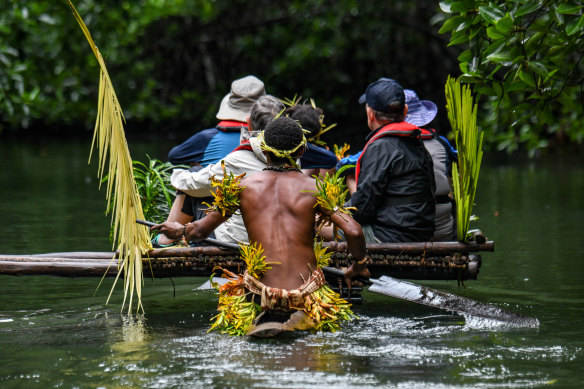
Canoeing into the Tufi fjords.
PNG is humid, but after excursions I fall back into Ponant’s air-conditioned comfort. I tuck into beef tenderloin with truffle jus as we sail past jungle scenery where hornbills fly. No worries about the lack of roads, hotels, fine dining or Bordeaux wines in PNG. Le Soleal delivers it all. You can have your layered opera cake and eat it, too.
The padded luxury of my stateroom makes me happy. The shower gushes. The bed is good, the ship’s engines quiet. The enchantment of expedition cruising is that you can be wafted off to sleep and wake up next morning somewhere new and implausibly remote.
We take to Zodiacs again for a landing on a coral atoll. Wanam Island supports 200 people who live from fishing and their excellent skills in wooden-bowl making. Their church is modest, and houses look as if they could be blown down by the big bad wolf. I’m pleased the best building is the prefab school. From its ceiling hangs alphabet bunting. Giggling kids follow us around the island, eager to practise their English.
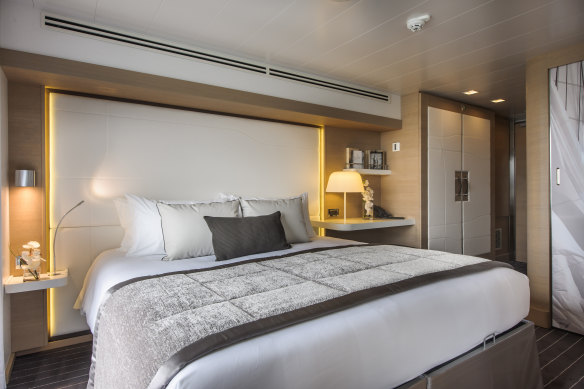
A stateroom on board Le Soleal.
I’m at lunch when the ship’s anchor rattles and we’re off. Le Soleal is a small ship of 264 passengers and has just two dining venues, but who’s complaining? The main restaurant has four-course a la carte dinners; five if you want cheese. The informal buffet venue tempts with inventive salads and hot mains such as herb-crusted lamb or pan-fried fish.
Ponant is a French company, and the bread and pastries are excellent. I linger over blue cheese with baguette and an outrageous chocolate mousse as the afternoon’s scenic sail takes us along the coast. Occasional villages are absurdly remote, but Le Soleal glides undeterred by PNG’s topographical challenges.
Our next stop, Madang, has coral sea walls that give it a raffish air, like a fortified pirate base. White houses give way to an industrial area. We dock by a dishevelled copra warehouse that fell down in a recent earthquake. Girders are piled like a ruined game of Jenga.
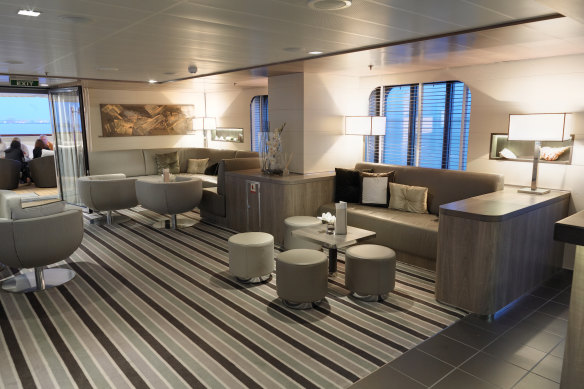
The main lounge on Le Soleal.
With 30,000 residents, Madang is PNG’s fourth-largest city, attracting those looking to work and study. It’s a mix of coastal and highland people, and others from islands such as Bougainville. Representatives of these groups are gathered at the cultural centre.
Women dance in grass skirts and feathered headdresses. The men are six-packed but implausible warriors with impish grins. Many are college students studying agriculture or business, proud to showcase their heritage, but not giving into the stereotype of jungle tribespeople.
And so we sail. I have breakfast on the terrace, French flag flapping, water sloshing gently in the pool. We slip between islands and into a harbour backed by hills. The Huon Gulf is one of PNG’s most remote places, with strongly preserved traditions and culture.
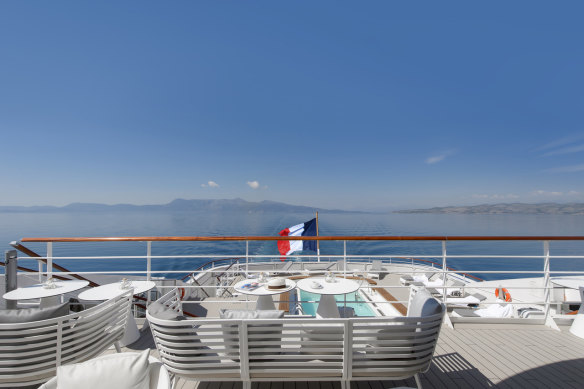
Breakfast with splashy views.Credit: Ponant
The ceremonial welcome and cultural performance here is amateurish but endearing. The people are cheerful and eager to communicate. All day, teenagers in outriggers hang around the back of the ship like pilot fish, hollering and hooting in delight.
Later in the Lusancay Islands, the lagoon is a tourist-brochure cliche. Where it drops into deep water the corals are spectacular and swarm with schools of fish outrageous as drag queens in stripes and dots and feathered fins.
Our last stop is Samarai Island, a colonial-era trading and missionary post abandoned in the 1960s, leaving only villagers to give tours of abandoned buildings. I’m pleased again with the primary school, snug amid flowerbeds and posted with signs urging students to be skilled, literate and community minded.
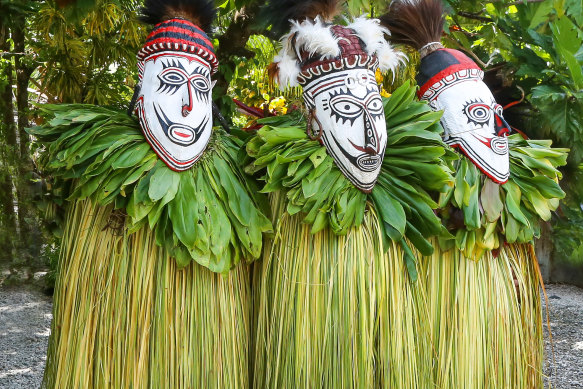
Tami islands welcome ceremony.
As we sail away, the last thing I see in PNG is an outrigger, bobbing in our wake. Its occupant stares at the ship and waves. Someone just like me, curious about the wider world, and filled with the need to know more.
THE DETAILS
Cruise
Ponant’s 12-night “Culture and Nature in Papua New Guinea” cruise round-trip from Cairns sails next on March 7, 2024. From $13,000 a person. The itinerary differs somewhat from the one described here. Several other Ponant cruises take in PNG in March and October-November 2024 and January-April 2025, on itineraries that also visit the Solomon Islands, Indonesia or New Caledonia. Ponant also operates expedition cruises in Australia, New Zealand, other Pacific islands and across the world. See ponant.com
The writer was a guest of Ponant.
Sign up for the Traveller Deals newsletter
Get exclusive travel deals delivered straight to your inbox. Sign up now.